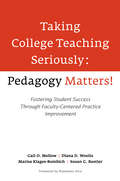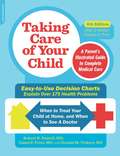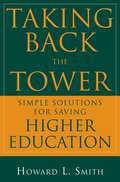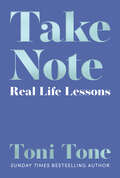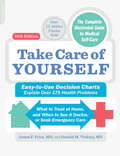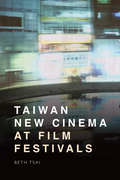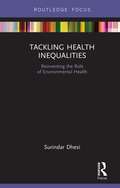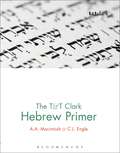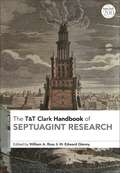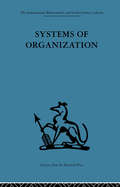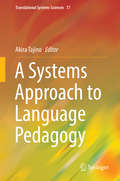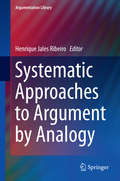- Table View
- List View
Taking College Teaching Seriously - Pedagogy Matters!: Fostering Student Success Through Faculty-Centered Practice Improvement
by Gail O. Mellow Diana D. Woolis Marisa Klages-Bombich Susan Restler“College teaching is not rocket science – it’s much, much harder.” Diana Laurillard, University of LondonCollege faculty, both adjunct and full-time, stand with their students at the coalface of learning, wishing for more to succeed and disappointed at how illusory academic success is for so many. Among the array of investments colleges are making to improve student outcomes, from predictive data analysis to enhanced advising, too little attention is paid to supporting faculty. Yet the impact of teacher and teaching on student learning is incontrovertible. Taking College Teaching Seriously: Pedagogy Matters! stands against the tide – celebrating the incredible work faculty members do each day and challenging them to expand their capacity to present their content expertise effectively. This book presents a model of embedded professional development, which capitalizes on the affordances of technology to enable groups of faculty to examine their practice in a non-evaluative context, but with a clear focus on improvement. The core of the work involves individual reflection and the design provides for an accessible way to “see” into the classrooms of discipline peers. Most importantly, the Taking College Teaching Seriously experience is not an intense one-shot, but rather a structured opportunity for a faculty member to examine and adapt practice over time and to assess the impact of changes on student learning. Faculty who have participated in the Taking College Teaching Seriously experience found it to be transformative:• English Professor, Kentucky: Participating in (the work) this year has helped me to be more reflective in every single action. I constantly analyze how each session went… (it) gave me the tools to think about every minute detail of a classroom.• Adjunct Math Professor, Mississippi: Speaking as an adjunct, I have valued the chance to share my teaching and get ideas from others. I can honestly say that this experience has been a lifeline of sorts this year. In a “magic wand” instructional setting, I’d wish for the kind of honest, respectful and professionally challenging discussions we have in Classroom Notebook* at weekly staff meetings.*Classroom Notebook is the Taking College Teaching Seriously online platform• Math Professor, NJ: I think the continual self-evaluation and reflection allowed us to work together to brainstorm improvements and positive tweaks to be more purposeful in our classrooms as opposed to just randomly reaching in the dark for ideas and techniques in HOPE of success.Taking College Teaching Seriously: Pedagogy Matters! breaks new ground in professional development. Each faculty member is at the center of the learning experience, stimulated and supported by peers working in similar contexts. They share a desire to see more students learn deeply and find that honing their skill at adapting to the learning needs of specific classes and students allows them to realize this goal. Uniquely, Taking College Teaching Seriously illuminates the link between faculty teaching expertise and improving student outcomes.The introduction to the book examines the challenges facing faculty in higher education today and reviews the literature on teaching and learning. Chapter 1 looks at the analytical foundations for all of the model’s elements, from adult learning theory to communities of practice, and Chapter 2 presents the model’s theory of change. Chapter 3 describes the model in detail and Chapters 4 and 5 concern the infrastructure of the faculty collaborative community, focusing on both its interpersonal and technological dimensions. The book concludes in Chapter 6 with an assessment of the value of this approach to professional development and a call to action for faculty member engagement in this important work, so essential to both professional passion and mandate.
Taking Care of Your Child, Ninth Edition: A Parent's Illustrated Guide to Complete Medical Care
by James F. Fries Donald M. Vickery Robert H. PantellThe bestselling indispensable resource for parents and caregivers, covering more than 175 common symptoms and health care problems, to raise a healthy, happy childFor more than forty years, Taking Care of Your Child has been the go-to resource for parents and caregivers. It offers the most recent information on critical childcare issues, from what to do in the event of a minor injury to everyday issues such as common allergies and ailments. Covering everything from birth to infancy and toddlerhood, to first concerns, growth and development, and the most common injuries and concerns through adolescence, Taking Care of Your Child is easy to use, even in a crisis: you can simply look up a symptom to find a complete explanation of probable causes, how to treat the problem at home, and when to see a doctor. With the very latest on ADHD, autism, breast-feeding, childhood depression and obesity, discipline, immunizations, and more, the book also features sections on youth sports and head trauma, genetic screening, and minimizing risks of medical procedures.
Taking Back the Tower: Simple Solutions for Saving Higher Education
by Howard L. SmithAcademia is in trouble. Taxpayers are fed up with the enormous expenses associated with public universities, as well as administrators whose strategies and goals are fuzzy at best and destructive at worst. Parents worry about how they will find the wherewithal to send their offspring to college. Employers question the ability of new graduates and degree holders to write or reason lucidly. And everyone (except entrenched faculty members) questions the practice of tenure, which generally creates an incentive for mediocrity. Meanwhile, academic authorities responsible for managing our august institutions of higher education pontificate about the problems without delivering meaningful solutions. But meaningful solutions do exist, and this book explains them in depth. Taking Back the Tower, a compendium of no-nonsense, management-oriented lessons and prescriptions for the academy, will go a long way toward restoring the respect our colleges and universities deserve.Taking Back the Tower focuses squarely on bringing common sense to higher education by urging creative thinking, especially out-of-the-box approaches, in promoting change. It offers numerous solutions, many of which will be seen as quite controversial by the establishment. Smith outlines how to overcome resistance to change, lead more effectively, demand accountability for performance, manage resources for the highest return, remain firm with tuition payers and donors when warranted, manage costs to help keep the price of an education contained, and much more. The secret is in managing the few key variables that will have the biggest impact on overall results. The ideas are wholly practical and much less philosophical than those in most books on the subject. Following them will help schools improve results across the board. Smith's decades of experience as both a teacher and administrator in academia, as well as a consultant for many public and private-sector organizations, make him the perfect author for this book. Moreover, his insights, coupled with the many enlightening and entertaining examples (all true) will capture the attention of readers and help them understand why change must come—and why it must be radical.
Take Note: Real Life Lessons
by Toni ToneFollowing on from her Sunday Times bestseller, I Wish I Knew This Earlier, Toni Tone is back again – and this time, filled with advice that goes beyond our dating and romantic lives.
Take Care of Yourself, 10th Edition: The Complete Illustrated Guide to Self-Care
by Donald M Vickery James F FriesA revised edition of the classic self-care guide, with new research on aging. "Every family should have this book"(Annals of Internal Medicine).Continuing to break new ground after forty years in print, Take Care of Yourself is the go-to guide for at home self-care. Simple to use, even in a crisis, the easy-to-navigate flowcharts help you quickly look up your symptoms and find an explanation of likely causes and possible home remedies, as well as advice on when you should go see a doctor. This comprehensive guide covers emergencies, over 175 healthcare concerns, the twenty things you should keep in a home pharmacy, and how to work best with your doctor. This new edition explains the latest research on how to postpone aging and what you can do to prevent chronic illness and stay in your best shape as you age. With new information on the Zika virus, prescription pain relievers, and other pertinent updates throughout, Take Care of Yourself remains your path to the most comprehensive and dependable self-care.
Taiwan New Cinema at Film Festivals
by Beth TsaiRevisits Taiwan New Cinema in relation to film festivals from cultural, historical, and geopolitical standpoints Look at the productive roles women have played as discursive mediators of the cultural imaginary of the nation, the auteur, and the art of slow cinema Offers accounts of the film festival’s role in both commissioning and exhibiting films Examines film aesthetics influenced by directors’ diasporic identities, moving across different regions and nations, such as Malaysia, France, Japan, Myanmar, and Taiwan Provides in-depth case studies on films by three Taiwan-based directors: Hou Hsiao-hsien, Tsai Ming-liang, and Midi Z/Zhao Deyin Complements the scope of and discussions on transnational cinema Taiwan New Cinema (first wave, 1982–1989; second wave, 1990 onward) has a unique history regarding film festivals, particularly in the way these films are circulated at major European film festivals. It shares a common formalist concern about cinematic modernism with its Western counterparts, departing from previous modes of filmmaking that were preoccupied with nostalgically romanticizing China’s image. Through utilising in-depth case studies of films by Taiwan-based directors: Tsai Ming-liang, Zhao Deyin and Hou Hsiao-hsien, Tsai discusses how Taiwan New Cinema represents a struggling configuration of the ‘nation’, brought forth by Taiwan’s multilayered colonial and postcolonial histories. Taiwan New Cinema at Film Festivals presents the conditions that have led to the production of a national cinema, branding the auteur, and examines shifting representations of cultural identity in the context of globalization.
Taiwan New Cinema at Film Festivals
by Beth TsaiRevisits Taiwan New Cinema in relation to film festivals from cultural, historical, and geopolitical standpoints Look at the productive roles women have played as discursive mediators of the cultural imaginary of the nation, the auteur, and the art of slow cinema Offers accounts of the film festival’s role in both commissioning and exhibiting films Examines film aesthetics influenced by directors’ diasporic identities, moving across different regions and nations, such as Malaysia, France, Japan, Myanmar, and Taiwan Provides in-depth case studies on films by three Taiwan-based directors: Hou Hsiao-hsien, Tsai Ming-liang, and Midi Z/Zhao Deyin Complements the scope of and discussions on transnational cinema Taiwan New Cinema (first wave, 1982–1989; second wave, 1990 onward) has a unique history regarding film festivals, particularly in the way these films are circulated at major European film festivals. It shares a common formalist concern about cinematic modernism with its Western counterparts, departing from previous modes of filmmaking that were preoccupied with nostalgically romanticizing China’s image. Through utilising in-depth case studies of films by Taiwan-based directors: Tsai Ming-liang, Zhao Deyin and Hou Hsiao-hsien, Tsai discusses how Taiwan New Cinema represents a struggling configuration of the ‘nation’, brought forth by Taiwan’s multilayered colonial and postcolonial histories. Taiwan New Cinema at Film Festivals presents the conditions that have led to the production of a national cinema, branding the auteur, and examines shifting representations of cultural identity in the context of globalization.
The Taiwan Issue: Problems and Prospects (Europa Country Perspectives)
by Benjamin Schreer Andrew T. H. TanWhile global attention has been focused on other regional issues, such as China-US tensions and North Korea’s nuclear ambitions, little attention has been paid to Taiwan. Yet the so-called Taiwan issue, namely the continued separation of the island from mainland China, remains a major regional security challenge that could potentially spark direct conflict involving the USA, China and Japan, the three largest economies in the world, two of which are nuclear powers. Although Taiwan has continued to find opportunities to maintain the current status quo despite a deteriorating geo-strategic environment as a result of the rise of China and the uncertainties of the Trump Administration, its room for manoeuvre continues to narrow. This volume examines the challenges and evaluates the prospects for preventing conflict on the Taiwan Strait, by focusing on the political conditions that Taiwan faces internally and externally.
The Taiwan Issue: Problems and Prospects (Europa Country Perspectives)
by Benjamin Schreer Andrew T. H. TanWhile global attention has been focused on other regional issues, such as China-US tensions and North Korea’s nuclear ambitions, little attention has been paid to Taiwan. Yet the so-called Taiwan issue, namely the continued separation of the island from mainland China, remains a major regional security challenge that could potentially spark direct conflict involving the USA, China and Japan, the three largest economies in the world, two of which are nuclear powers. Although Taiwan has continued to find opportunities to maintain the current status quo despite a deteriorating geo-strategic environment as a result of the rise of China and the uncertainties of the Trump Administration, its room for manoeuvre continues to narrow. This volume examines the challenges and evaluates the prospects for preventing conflict on the Taiwan Strait, by focusing on the political conditions that Taiwan faces internally and externally.
Tagalog Verb Dictionary
by Michael C. Hawkins Rhodalyne Gallo-crailThis handy reference is a concise explanatory text and English-Tagalog/Tagalog-English verb guide designed to address and facilitate the most important aspect of Tagalog language learning—understanding and mastering the complex focal orientation of verbs. It is organized into an accessible pattern illustrating the primary conjugations that establish aspect and actor/object focus for each verb. These verbs are further enhanced by sample sentences demonstrating their usage and introducing common cultural contexts for effective communication. In addition to the verb guide, this text also provides a short history of Tagalog, an extensive explanation of verbal function in the language, and a number of learners' tips intended to ease and expedite the learning process. Taken together, these materials, along with a persistent willingness to engage the language, will facilitate a quick and effective path to fluency. Whether one is studying within the structured environment of a classroom or independently in their spare time, this book is designed to give special attention to the most critical aspects of Tagalog language learning. Tagalog Verb Dictionary's orderly and easily accessible layout and neat size make it the ideal companion for students, travelers, and anyone interested in fast fluency in the language.
Tackling Health Inequalities: Reinventing the Role of Environmental Health (Routledge Focus on Environmental Health)
by Surindar Kishen DhesiAlthough environmental health has received some recognition as a field which can positively impact on the social determinants of health, it remains little known outside its immediate sphere of influence. There is also limited literature available to support the potential impact of the profession in public health policy circles, and there has been an overreliance on anecdotal rather than firm evidence. This book presents the findings of an empirical research project focussed on public health policymaking (English Health and Wellbeing Boards), health inequalities and environmental health and provides an insight to the environmental health profession and routes of impact and influence. It discusses environmental health in the context of public health, the role of the profession, issues of visibility and opportunities for impact in today’s policy landscape. In particular, a focus on the local government context is timely given the shifting of the public health function from the National Health Service to local authorities. This book is essential reading for students, practitioners and policymakers in the fields of environmental health and public health.
Tackling Health Inequalities: Reinventing the Role of Environmental Health (Routledge Focus on Environmental Health)
by Surindar Kishen DhesiAlthough environmental health has received some recognition as a field which can positively impact on the social determinants of health, it remains little known outside its immediate sphere of influence. There is also limited literature available to support the potential impact of the profession in public health policy circles, and there has been an overreliance on anecdotal rather than firm evidence. This book presents the findings of an empirical research project focussed on public health policymaking (English Health and Wellbeing Boards), health inequalities and environmental health and provides an insight to the environmental health profession and routes of impact and influence. It discusses environmental health in the context of public health, the role of the profession, issues of visibility and opportunities for impact in today’s policy landscape. In particular, a focus on the local government context is timely given the shifting of the public health function from the National Health Service to local authorities. This book is essential reading for students, practitioners and policymakers in the fields of environmental health and public health.
The T&T Clark Hebrew Primer
by A. A. Macintosh C. L. EngleLearning Biblical Hebrew can be extremely difficult. Here at last is a book designed to work in conjunction with the many Hebrew Grammars available in order to break this complex language down into bite-size chunks for revision and consolidation of key aspects of grammar, as well as vocabulary. A.A. Macintosh and C.L. Engle combine insights from teaching Hebrew in both the United States and Europe, and between them bring some fifty years of experience of teaching Hebrew to undergraduate students to this clearly structured book.
T&T Clark Handbook of Septuagint Research (T&T Clark Handbooks)
by William A. Ross and W. Edward GlennyStudents and scholars now widely recognize the importance of the Septuagint to the history of the Greek language, the textual development of the Bible, and to Jewish and Christian religious life in both the ancient and modern worlds. This handbook is designed for those who wish to engage the Septuagint in their research, yet have been unsure where to turn for guidance or concise, up-to-date discussion. The contributors break down the barriers involved in the technical debates and sub-specialties as far as possible, equipping readers with the tools and knowledge necessary to conduct their own research. Each chapter is written by a leading Septuagint scholar and focuses upon a major area of research in the discipline, providing an overview of the topic, key debates and views, a survey or demonstration of the methods involved, and pointers towards ongoing research questions. By exploring origins, language, text, reception, theology, translation, and commentary, with a final summary of the literature, this handbook encourages active engagement with the most important issues in the field and provides an essential resource for specialists and non-specialists alike.
T&T Clark Handbook of Septuagint Research (T&T Clark Handbooks)
Students and scholars now widely recognize the importance of the Septuagint to the history of the Greek language, the textual development of the Bible, and to Jewish and Christian religious life in both the ancient and modern worlds. This handbook is designed for those who wish to engage the Septuagint in their research, yet have been unsure where to turn for guidance or concise, up-to-date discussion. The contributors break down the barriers involved in the technical debates and sub-specialties as far as possible, equipping readers with the tools and knowledge necessary to conduct their own research. Each chapter is written by a leading Septuagint scholar and focuses upon a major area of research in the discipline, providing an overview of the topic, key debates and views, a survey or demonstration of the methods involved, and pointers towards ongoing research questions. By exploring origins, language, text, reception, theology, translation, and commentary, with a final summary of the literature, this handbook encourages active engagement with the most important issues in the field and provides an essential resource for specialists and non-specialists alike.
T&T Clark Encyclopedia of Second Temple Judaism Volume Two
by Daniel M. Gurtner Loren T. StuckenbruckThe T&T Clark Encyclopedia of Second Temple Judaism provides a comprehensive reference resource of over 600 scholarly articles aimed at scholars and students interested in Judaism of the Second Temple Period. The two-volume work is split into four parts. Part One offers a prolegomenon for the contemporary study and appreciation of Second Temple Judaism, locating the discipline in relation to other relevant fields (such as Hebrew Bible, Rabbinics, Christian Origins). Beginning with a discussion of terminology, the discussion suggests ways the Second Temple period may be described, and concludes by noting areas of study that challenge our perception of ancient Judaism. Part Two presents an overview of respective contexts of the discipline set within the broad framework of historical chronology corresponding to a set of full-colour, custom-designed maps. With distinct attention to primary sources, the author traces the development of historical, social, political, and religious developments from the time period following the exile in the late 6th century B.C.E. through to the end of the Bar Kokhba revolt (135 C.E.). Part Three focuses specifically on a wide selection of primary-source literature of Second Temple Judaism, summarizing the content of key texts, and examining their similarities and differences with other texts of the period. Essays here include a brief introduction to the work and a summary of its contents, as well as examination of critical issues such as date, provenance, location, language(s), and interpretative matters. The early reception history of texts is also considered, and followed by a bibliography specific to that essay. Numerous high-resolution manuscript images are utilized to illustrate distinct features of the texts. Part Four addresses topics relevant to the Second Temple Period such as places, practices, historical figures, concepts, and subjects of scholarly discussion. These are often supplemented by images, maps, drawings, or diagrams, some of which appear here for the first time. Copiously illustrated, carefully researched and meticulously referenced, this resource provides a reliable, up-to-date and complete guide for those studying early Judaism in its literary and historical settings.
T&T Clark Encyclopedia of Second Temple Judaism Volume Two
by Loren T. Stuckenbruck Daniel M. GurtnerThe T&T Clark Encyclopedia of Second Temple Judaism provides a comprehensive reference resource of over 600 scholarly articles aimed at scholars and students interested in Judaism of the Second Temple Period. The two-volume work is split into four parts. Part One offers a prolegomenon for the contemporary study and appreciation of Second Temple Judaism, locating the discipline in relation to other relevant fields (such as Hebrew Bible, Rabbinics, Christian Origins). Beginning with a discussion of terminology, the discussion suggests ways the Second Temple period may be described, and concludes by noting areas of study that challenge our perception of ancient Judaism. Part Two presents an overview of respective contexts of the discipline set within the broad framework of historical chronology corresponding to a set of full-colour, custom-designed maps. With distinct attention to primary sources, the author traces the development of historical, social, political, and religious developments from the time period following the exile in the late 6th century B.C.E. through to the end of the Bar Kokhba revolt (135 C.E.). Part Three focuses specifically on a wide selection of primary-source literature of Second Temple Judaism, summarizing the content of key texts, and examining their similarities and differences with other texts of the period. Essays here include a brief introduction to the work and a summary of its contents, as well as examination of critical issues such as date, provenance, location, language(s), and interpretative matters. The early reception history of texts is also considered, and followed by a bibliography specific to that essay. Numerous high-resolution manuscript images are utilized to illustrate distinct features of the texts. Part Four addresses topics relevant to the Second Temple Period such as places, practices, historical figures, concepts, and subjects of scholarly discussion. These are often supplemented by images, maps, drawings, or diagrams, some of which appear here for the first time. Copiously illustrated, carefully researched and meticulously referenced, this resource provides a reliable, up-to-date and complete guide for those studying early Judaism in its literary and historical settings.
T&T Clark Encyclopedia of Second Temple Judaism Volume One
by Daniel M. Gurtner Loren T. StuckenbruckThe T&T Clark Encyclopedia of Second Temple Judaism provides a comprehensive reference resource of over 600 scholarly articles aimed at scholars and students interested in Judaism of the Second Temple Period. The two-volume work is split into four parts. Part One offers a prolegomenon for the contemporary study and appreciation of Second Temple Judaism, locating the discipline in relation to other relevant fields (such as Hebrew Bible, Rabbinics, Christian Origins). Beginning with a discussion of terminology, the discussion suggests ways the Second Temple period may be described, and concludes by noting areas of study that challenge our perception of ancient Judaism. Part Two presents an overview of respective contexts of the discipline set within the broad framework of historical chronology corresponding to a set of full-colour, custom-designed maps. With distinct attention to primary sources, the author traces the development of historical, social, political, and religious developments from the time period following the exile in the late 6th century B.C.E. through to the end of the Bar Kokhba revolt (135 C.E.). Part Three focuses specifically on a wide selection of primary-source literature of Second Temple Judaism, summarizing the content of key texts, and examining their similarities and differences with other texts of the period. Essays here include a brief introduction to the work and a summary of its contents, as well as examination of critical issues such as date, provenance, location, language(s), and interpretative matters. The early reception history of texts is also considered, and followed by a bibliography specific to that essay. Numerous high-resolution manuscript images are utilized to illustrate distinct features of the texts. Part Four addresses topics relevant to the Second Temple Period such as places, practices, historical figures, concepts, and subjects of scholarly discussion. These are often supplemented by images, maps, drawings, or diagrams, some of which appear here for the first time. Copiously illustrated, carefully researched and meticulously referenced, this resource provides a reliable, up-to-date and complete guide for those studying early Judaism in its literary and historical settings.
T&T Clark Encyclopedia of Second Temple Judaism Volume One
by Loren T. Stuckenbruck Daniel M. GurtnerThe T&T Clark Encyclopedia of Second Temple Judaism provides a comprehensive reference resource of over 600 scholarly articles aimed at scholars and students interested in Judaism of the Second Temple Period. The two-volume work is split into four parts. Part One offers a prolegomenon for the contemporary study and appreciation of Second Temple Judaism, locating the discipline in relation to other relevant fields (such as Hebrew Bible, Rabbinics, Christian Origins). Beginning with a discussion of terminology, the discussion suggests ways the Second Temple period may be described, and concludes by noting areas of study that challenge our perception of ancient Judaism. Part Two presents an overview of respective contexts of the discipline set within the broad framework of historical chronology corresponding to a set of full-colour, custom-designed maps. With distinct attention to primary sources, the author traces the development of historical, social, political, and religious developments from the time period following the exile in the late 6th century B.C.E. through to the end of the Bar Kokhba revolt (135 C.E.). Part Three focuses specifically on a wide selection of primary-source literature of Second Temple Judaism, summarizing the content of key texts, and examining their similarities and differences with other texts of the period. Essays here include a brief introduction to the work and a summary of its contents, as well as examination of critical issues such as date, provenance, location, language(s), and interpretative matters. The early reception history of texts is also considered, and followed by a bibliography specific to that essay. Numerous high-resolution manuscript images are utilized to illustrate distinct features of the texts. Part Four addresses topics relevant to the Second Temple Period such as places, practices, historical figures, concepts, and subjects of scholarly discussion. These are often supplemented by images, maps, drawings, or diagrams, some of which appear here for the first time. Copiously illustrated, carefully researched and meticulously referenced, this resource provides a reliable, up-to-date and complete guide for those studying early Judaism in its literary and historical settings.
Systems of Organization: The control of task and sentient boundaries
by E. J. Miller A. K. RiceTavistock Press was established as a co-operative venture between the Tavistock Institute and Routledge & Kegan Paul (RKP) in the 1950s to produce a series of major contributions across the social sciences. This volume is part of a 2001 reissue of a selection of those important works which have since gone out of print, or are difficult to locate. Published by Routledge, 112 volumes in total are being brought together under the name The International Behavioural and Social Sciences Library: Classics from the Tavistock Press. Reproduced here in facsimile, this volume was originally published in 1967 and is available individually. The collection is also available in a number of themed mini-sets of between 5 and 13 volumes, or as a complete collection.
Systems of Organization: The control of task and sentient boundaries
by E. J. Miller A. K. RiceTavistock Press was established as a co-operative venture between the Tavistock Institute and Routledge & Kegan Paul (RKP) in the 1950s to produce a series of major contributions across the social sciences. This volume is part of a 2001 reissue of a selection of those important works which have since gone out of print, or are difficult to locate. Published by Routledge, 112 volumes in total are being brought together under the name The International Behavioural and Social Sciences Library: Classics from the Tavistock Press. Reproduced here in facsimile, this volume was originally published in 1967 and is available individually. The collection is also available in a number of themed mini-sets of between 5 and 13 volumes, or as a complete collection.
A Systems Approach to Language Pedagogy (Translational Systems Sciences #17)
by Akira TajinoThis volume represents the first attempt in the field of language pedagogy to apply a systems approach to issues in English language education. In the literature of language education, or more specifically, second or foreign language learning and teaching, each topic or issue has often been dealt with independently, and been treated as an isolated item. Taking grammar instruction as an example, grammatical items are often taught in a sequential, step-by-step manner; there has been no “road map” in which the interrelations between the various items are demonstrated. This may be one factor that makes it more difficult for students to learn the language organically. The topics covered in this volume, including language acquisition, pedagogical grammar, and teacher collaboration, are viewed from a holistic perspective. In other words, language pedagogy is approached as a dynamic system of interrelations. In this way, “emergent properties” are expected to manifest. This book is recommended for anyone involved in language pedagogy, including researchers, teachers, and teacher trainers, as well as learners.
Systematic Approaches to Argument by Analogy (Argumentation Library #25)
by Henrique Jales RibeiroThe present volume assembles a relevant set of studies of argument by analogy, which address this topic in a systematic fashion, either from an essentially theoretical perspective or from the perspective of it being applied to different fields like politics, linguistics, literature, law, medicine, science in general and philosophy. All result from original research conducted by their authors for this publication. Thus, broadly speaking, this is an exception which we find worthy of occupying a special place in the sphere of the bibliography on the argument by analogy. In effect, most of the contexts of the publications on this topic focus on specific areas, for example everyday discourse, science or law theory, while underestimating or sometimes even ignoring other interdisciplinary scopes, as is the case of literature, medicine or philosophy. The idiosyncrasy of this volume is that the reader and the researcher may follow the development of different theoretical outlooks on argument by analogy, while measuring the scope of its (greater or lesser) application to the aforementioned areas as a whole.
Systematic Approaches to a Successful Literature Review (PDF)
by Andrew Booth Diana Papaioannou Anthea SuttonReviewing the literature is an essential part of every research project. This book takes you step-by-step through the process of approaching your literature review systematically, applying systematic principles to a wide range of literature review types. Through numerous examples, case studies and exercises, the book covers often neglected areas of literature review such as concept analysis, scoping and mapping. The book includes practical tools for supporting the various stages of the review process, including; - managing your literature review - searching the literature - assessing the quality of the literature - synthesising qualitative and/or quantitative data - writing up and presenting data Systematic Approaches to a Successful Literature Review is essential reading for any student or researcher looking to approach their literature review in a systematic way.
Systematic Approaches to a Successful Literature Review (PDF)
by Andrew Booth Anthea Sutton Diana PapaioannouReviewing the literature is an essential part of every research project. This book takes you step-by-step through the process of approaching your literature review systematically, applying systematic principles to a wide range of literature review types. Through numerous examples, case studies and exercises, the book covers often neglected areas of literature review such as concept analysis, scoping and mapping. The book includes practical tools for supporting the various stages of the review process, including; - managing your literature review - searching the literature - assessing the quality of the literature - synthesising qualitative and/or quantitative data - writing up and presenting data Systematic Approaches to a Successful Literature Review is essential reading for any student or researcher looking to approach their literature review in a systematic way.
